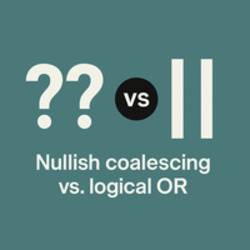?? vs || — Why Nullish Coalescing is Better for Default Values?
Mon, April 21, 2025 - 2 min read

❓ ?? vs || — Choose Wisely
In JavaScript, we often set default values like this:
const value = input || 'default';But this can be a trap.
⚠️ The Problem with ||
The || operator returns the first “truthy” value.
So if input is '' (empty string) or 0 (zero), it treats them as false and replaces them.
console.log(0 || 10); // 10
console.log('' || 'default'); // 'default'❗️ That’s not always the behavior you want.
✅ The Solution — ??
The nullish coalescing operator (??) works differently:
It provides the default value only if the variable is null or undefined, not just “falsy”.
console.log(0 ?? 10); // 0
console.log('' ?? 'default'); // ''
console.log(undefined ?? 'fallback'); // 'fallback'💡 When to Use ??
| Scenario | Keep value? | Use |
|---|---|---|
0 is a valid value | Yes | ✅ ?? |
Empty string '' is allowed | Yes | ✅ ?? |
Only null and undefined mean “missing” | Yes | ✅ ?? |
| Any falsy value means “missing” | No | ❌ || |
🧪 Real-Life Examples
✅ Product Price
const price = product.price ?? 0; // fallback to 0 if undefined✅ Input Value
const value = inputValue ?? ''; // allow empty string, but not undefined✅ Padding in Pixels
const padding = props.padding ?? 10; // 0 is allowed🔥 When is || Still Fine?
If any falsy value should be treated as “missing”, || works:
const isDark = userPrefersDark || false;Here false, 0, '' — all mean “no”.
📝 Summary
- 🛑
||doesn’t distinguish betweenfalse,0,'', andundefined. - ✅
??only applies fallback for null or undefined. - 🤓
??is safer in most cases. - 📌 Use
??if you want to keep0,false, or''.
The ?? operator is the modern standard for default values.
Don’t let falsy values trick you 🙃
📘 Want more practical tips like this? Follow Telegram channel and check out my other articles!